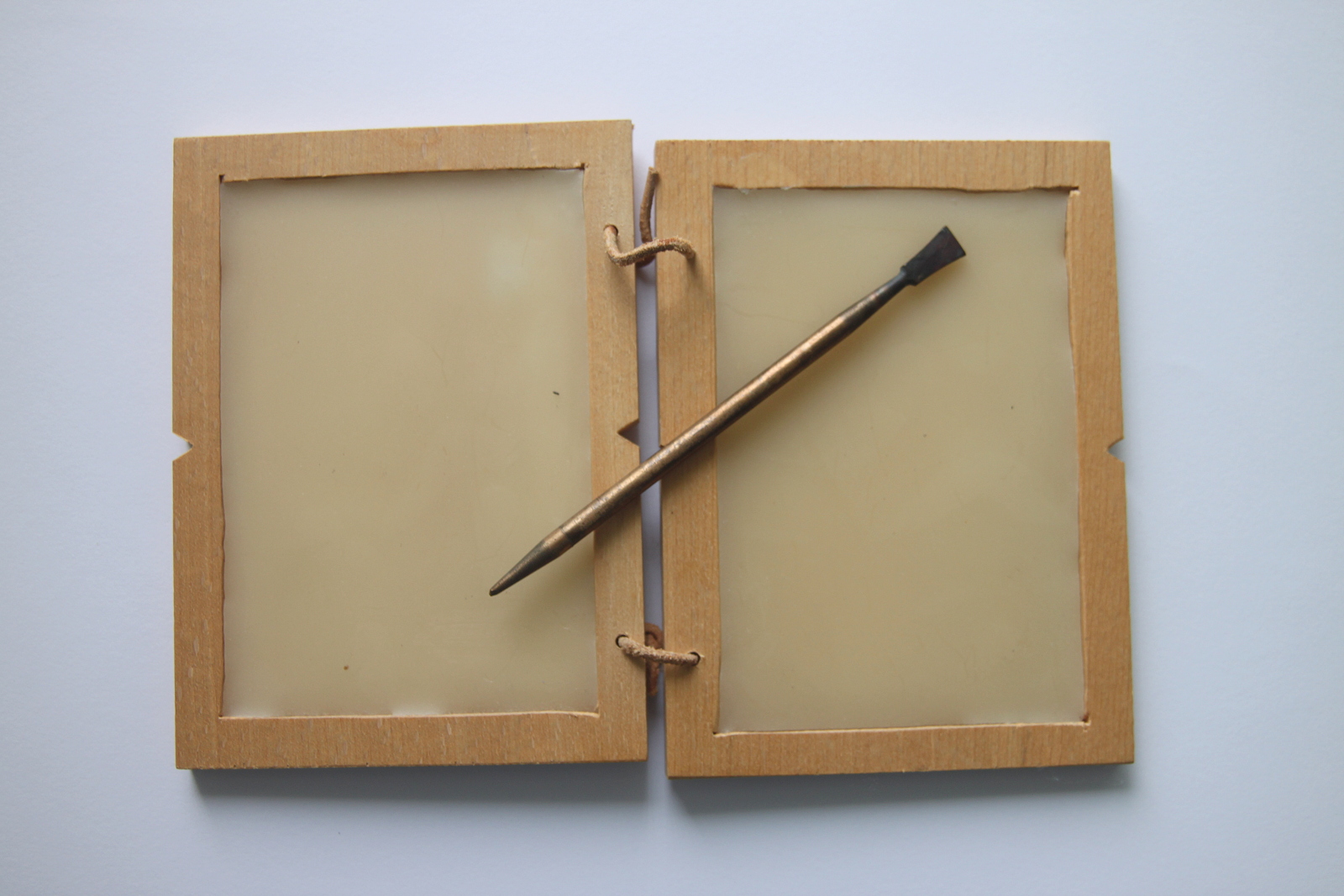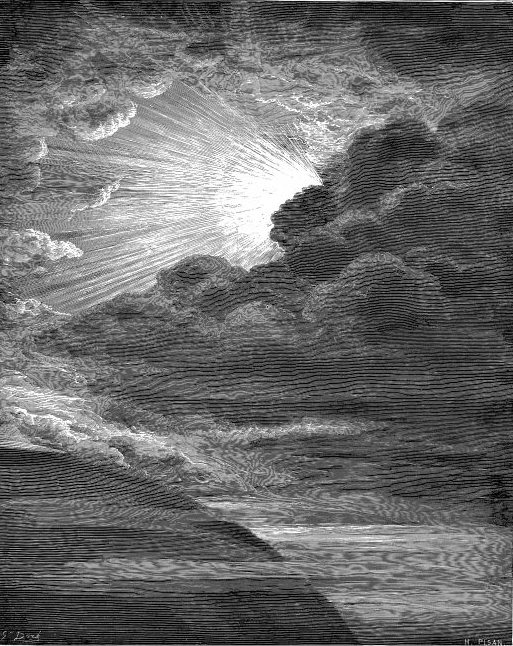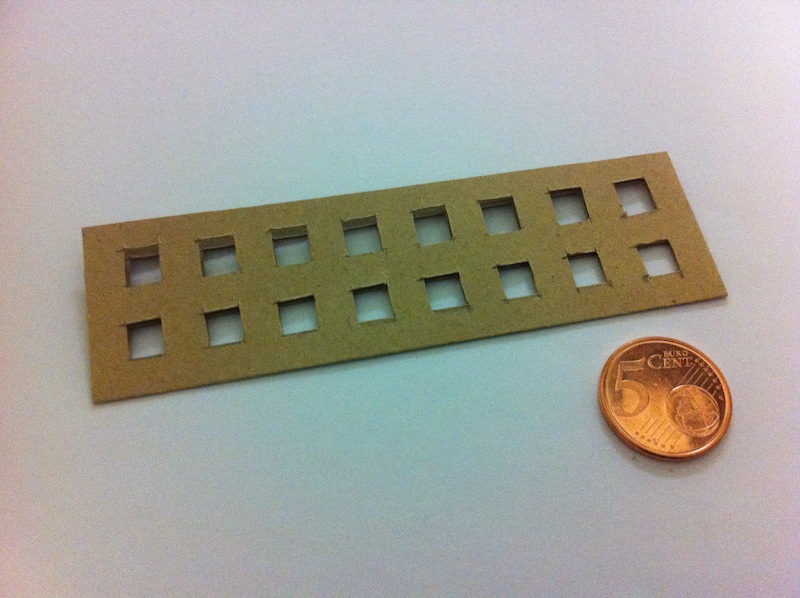|
Noctograph
A noctograph is a writing instrument composed of a piece of paper whose underside is treated with printer's ink carbon paper and a metal board with clips to hold the paper in place and guidelines to make for straight writing in the dark. The user writes with a metal stylus, and thus does not have to ink a pen or worry about knocking an inkstand over. The original purpose was to allow the blind or partially sighted to write with more ease than with a traditional pen, although it has also been used by the fully sighted to write in the dark. It was originally patented by Ralph Wedgwood in 1806. Notable users *William H. Prescott The noctograph that Prescott used to write his many historical volumes is on display at the William Hickling Prescott House (house museum) at 55 Beacon Street, Boston, Massachusetts. *James Holman See also *Nyctograph Nyctography is a form of substitution cipher writing created by Lewis Carroll (Charles Lutwidge Dodgson) in 1891. Nyctography is writt ... [...More Info...] [...Related Items...] OR: [Wikipedia] [Google] [Baidu] |
Ralph Wedgwood (inventor)
Ralph Wedgwood (1766–1837) was an English inventor and member of the Wedgwood family of potters. His most notable invention was the earliest form of carbon paper, a method of creating duplicate paper documents, which he called "stylographic writer" or Noctograph. He obtained a patent for the invention in 1806. Wedgwood was born in Burslem, Staffordshire. He was the eldest son of the potter Thomas Wedgwood II (1734–1788) and his wife Elizabeth Taylor. He married three times and was widowed twice. His first marriage was to Mary Yeomans in 1790, and they had two children, Mary and Ralph, but he was widowed in 1795. He remarried Sarah Taylor; they had a son Samuel (1800–1863), but she, too, died in 1807. In 1808, he married for a third time, to Mary Anne Copeland, and they had three children: Trianne, Maria and William. His third wife survived him and died in 1867. Ralph was the cousin and business partner of Josiah Wedgwood. Funding for Ralph's inventions were provided by Jos ... [...More Info...] [...Related Items...] OR: [Wikipedia] [Google] [Baidu] |
Writing Instrument
A writing implement or writing instrument is an object used to produce writing. Writing consists of different figures, lines, and or forms. Most of these items can be also used for other functions such as painting, drawing and technical drawing, but writing instruments generally have the ordinary requirement to create a smooth, controllable line. Another writing implement employed by a smaller population is the stylus used in conjunction with the slate for punching out the dots in Braille. Autonomous An autonomous writing implement is one that cannot "run out"—the only way to render it useless is to destroy it. Without pigment The oldest known examples were created by incising a flat surface with a rigid tool rather than applying pigment with a secondary object, e.g., Chinese jiaguwen carved into turtle shells. However, this may simply represent the relative durability of such artifacts rather than truly representing the evolution of techniques, as the meaningful application ... [...More Info...] [...Related Items...] OR: [Wikipedia] [Google] [Baidu] |
Carbon Paper
Carbon paper (originally carbonic paper) consists of sheets of paper which create one or more copies simultaneously with the creation of an original document when inscribed by a typewriter or ballpoint pen. History In 1801, Pellegrino Turri, an Italian inventor, invented carbon paper to provide the ink for his mechanical typing machine, one of the first typewriters. Ralph Wedgwood obtained the first patent for carbon paper in 1806. Carbon paper in its original form was paper coated on one side with a layer of a loosely bound dry ink or pigmented coating, bound with wax. The manufacture of carbon paper was formerly the largest consumer of montan wax. In 1954 the Columbia Ribbon & Carbon Manufacturing Company filed a patent for what became known in the trade as solvent carbon paper: the coating was changed from wax-based to polymer-based. The manufacturing process changed from a hot-melt method to a solvent-applied coating or set of coatings. It was then possible to use po ... [...More Info...] [...Related Items...] OR: [Wikipedia] [Google] [Baidu] |
Stylus
A stylus (plural styli or styluses) is a writing utensil or a small tool for some other form of marking or shaping, for example, in pottery. It can also be a computer accessory that is used to assist in navigating or providing more precision when using touchscreens. It usually refers to a narrow elongated staff, similar to a modern ballpoint pen. Many styluses are heavily curved to be held more easily. Another widely used writing tool is the stylus used by blind users in conjunction with the slate for punching out the dots in Braille. Etymology The English word ''stylus'' has two plurals: ''styli'' and ''styluses''. The original Latin word was spelled ; the spelling ''stylus'' arose from an erroneous connection with Greek (), 'pillar'.''Oxford Latin Dictionary'', s.v. "stilus" (2012). The Latin word had several meanings, including "a long, sharply pointed piece of metal; the stem of a plant; a pointed instrument for incising letters; the stylus (as used in literary composi ... [...More Info...] [...Related Items...] OR: [Wikipedia] [Google] [Baidu] |
Blindness
Visual impairment, also known as vision impairment, is a medical definition primarily measured based on an individual's better eye visual acuity; in the absence of treatment such as correctable eyewear, assistive devices, and medical treatment– visual impairment may cause the individual difficulties with normal daily tasks including reading and walking. Low vision is a functional definition of visual impairment that is chronic, uncorrectable with treatment or correctable lenses, and impacts daily living. As such low vision can be used as a disability metric and varies based on an individual's experience, environmental demands, accommodations, and access to services. The American Academy of Ophthalmology defines visual impairment as the best-corrected visual acuity of less than 20/40 in the better eye, and the World Health Organization defines it as a presenting acuity of less than 6/12 in the better eye. The term blindness is used for complete or nearly complete vision loss. In ... [...More Info...] [...Related Items...] OR: [Wikipedia] [Google] [Baidu] |
Partially Sighted
Visual impairment, also known as vision impairment, is a medical definition primarily measured based on an individual's better eye visual acuity; in the absence of treatment such as correctable eyewear, assistive devices, and medical treatment– visual impairment may cause the individual difficulties with normal daily tasks including reading and walking. Low vision is a functional definition of visual impairment that is chronic, uncorrectable with treatment or correctable lenses, and impacts daily living. As such low vision can be used as a disability metric and varies based on an individual's experience, environmental demands, accommodations, and access to services. The American Academy of Ophthalmology defines visual impairment as the best-corrected visual acuity of less than 20/40 in the better eye, and the World Health Organization defines it as a presenting acuity of less than 6/12 in the better eye. The term blindness is used for complete or nearly complete vision loss. In ... [...More Info...] [...Related Items...] OR: [Wikipedia] [Google] [Baidu] |
Dark
Darkness, the direct opposite of lightness, is defined as a lack of illumination, an absence of visible light, or a surface that absorbs light, such as black or brown. Human vision is unable to distinguish colors in conditions of very low luminance. This is because the hue sensitive photoreceptor cells on the retina are inactive when light levels are insufficient, in the range of visual perception referred to as scotopic vision. The emotional response to darkness has generated metaphorical usages of the term in many cultures, often used to describe an unhappy or foreboding feeling. Referring to a time of day, complete darkness occurs when the Sun is more than 18° below the horizon, without the effects of twilight on the night sky. Scientific Perception The perception of darkness differs from the mere absence of light due to the effects of after images on perception. In perceiving, the eye is active, and the part of the retina that is unstimulated produces a complementary ... [...More Info...] [...Related Items...] OR: [Wikipedia] [Google] [Baidu] |
William H
William is a male given name of Germanic origin.Hanks, Hardcastle and Hodges, ''Oxford Dictionary of First Names'', Oxford University Press, 2nd edition, , p. 276. It became very popular in the English language after the Norman conquest of England in 1066,All Things William"Meaning & Origin of the Name"/ref> and remained so throughout the Middle Ages and into the modern era. It is sometimes abbreviated "Wm." Shortened familiar versions in English include Will, Wills, Willy, Willie, Bill, and Billy. A common Irish form is Liam. Scottish diminutives include Wull, Willie or Wullie (as in Oor Wullie or the play ''Douglas''). Female forms are Willa, Willemina, Wilma and Wilhelmina. Etymology William is related to the given name ''Wilhelm'' (cf. Proto-Germanic ᚹᛁᛚᛃᚨᚺᛖᛚᛗᚨᛉ, ''*Wiljahelmaz'' > German ''Wilhelm'' and Old Norse ᚢᛁᛚᛋᛅᚼᛅᛚᛘᛅᛋ, ''Vilhjálmr''). By regular sound changes, the native, inherited English form of the name shoul ... [...More Info...] [...Related Items...] OR: [Wikipedia] [Google] [Baidu] |
James Holman
James Holman FRS (15 October 1786 – 29 July 1857), known as the "Blind Traveller," was a British adventurer, author and social observer, best known for his writings on his extensive travels. Completely blind and experiencing pain and limited mobility, he undertook a series of solo journeys that were unprecedented both in their extent of geography and method of "human echolocation". In 1866, the journalist William Jerdan wrote that "From Marco Polo to Mungo Park, no three of the most famous travellers, grouped together, would exceed the extent and variety of countries traversed by our blind countryman." In 1832, Holman became the first blind person to circumnavigate the globe. He continued travelling, and by October 1846 had visited every inhabited continent. Life and travels Holman was born in Exeter, the son of an apothecary. He entered the British Royal Navy in 1798 as first-class volunteer, and was appointed lieutenant in April 1807. In 1810, while on the '' Guerri ... [...More Info...] [...Related Items...] OR: [Wikipedia] [Google] [Baidu] |
Nyctograph
Nyctography is a form of substitution cipher writing created by Lewis Carroll (Charles Lutwidge Dodgson) in 1891. Nyctography is written with a nyctograph (also invented by Carroll) and uses a system of dots and strokes all based on a dot placed in the upper left corner. Using the Nyctograph, one could quickly jot down ideas or notes without the aid of light. Carroll invented the Nyctograph and Nyctography because he was often awakened during the night with thoughts that needed to be written down immediately, and didn't want to go through the lengthy process of lighting a lamp just to have to extinguish it shortly thereafter. Nyctograph The device consisted of a gridded card with sixteen square holes, each a quarter inch wide, and system of symbols representing an alphabet of Carroll's design, which could then be transcribed the following day. He first named it "typhlograph" from , ("blind"), but at the suggestion of one of his brother-students, this was subsequently changed ... [...More Info...] [...Related Items...] OR: [Wikipedia] [Google] [Baidu] |
Writing Implements
A writing implement or writing instrument is an object used to produce writing. Writing consists of different figures, lines, and or forms. Most of these items can be also used for other functions such as painting, drawing and technical drawing, but writing instruments generally have the ordinary requirement to create a smooth, controllable line. Another writing implement employed by a smaller population is the stylus used in conjunction with the slate for punching out the dots in Braille. Autonomous An autonomous writing implement is one that cannot "run out"—the only way to render it useless is to destroy it. Without pigment The oldest known examples were created by incising a flat surface with a rigid tool rather than applying pigment with a secondary object, e.g., Chinese jiaguwen carved into turtle shells. However, this may simply represent the relative durability of such artifacts rather than truly representing the evolution of techniques, as the meaningful application ... [...More Info...] [...Related Items...] OR: [Wikipedia] [Google] [Baidu] |


.jpg)



